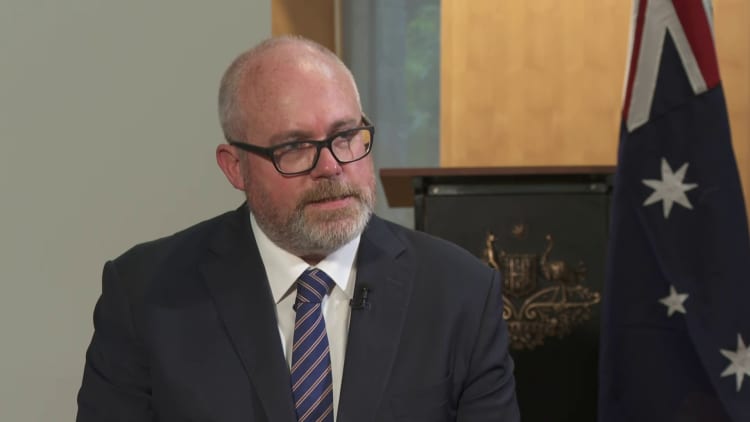[ad_1]
Katherine Tai, United States Trade Representative, speaks during the Senate Finance Committee Hearing on the President’s 2023 Trade Policy Agenda at the U.S. Capitol on March 23, 2023 in Washington, DC.
China News Service | China News Service | Getty Images
China’s dominance in rare earths makes U.S. supply chains vulnerable, U.S. Trade Representative Katherine Tai said in an exclusive interview Saturday with CNBC’s Martin Soong.
Rare earth metals are used in high-tech products such as electric car motors. Over the decades, China has built up its ability to process the metals — giving it enormous pricing power in a critical global market.
“What I want to draw your attention to is not just the vulnerabilities around China’s investments [overseas], but the fact that China’s dominant position in the world market now in [rare earths] means that it is able to turn on the faucet and turn off the faucet,” Tai said.
“And until we are able to access and create additional supply chains we remain entirely vulnerable to that leverage,” the U.S. trade representative said. Tai was speaking in New Delhi, India, on the sidelines of B20, the official business dialogue forum of the G20.
Tai pointed out that about a decade ago, China raised rare earths prices so high that some U.S. mines were able to operate in the industry again, only to have to close once China cut prices.
The U.S. held a majority stake in the rare earths metals market prior to the 1980s. But lower labor costs overseas, as well as less pressure on environmental standards, helped send the rare earths industry out of the U.S.
Meanwhile, Beijing supported the industry.
“The advantage in terms of China’s dominance isn’t necessarily a natural advantage,” Tai said. “It’s not that they have more rare earths but that they were able to pursue coordinated industrial and trade policies that allowed them to corner the market.”
The Chinese government sets economic plans at least every five years, with some goals — such as boosting self-sufficiency in technology and reaching carbon neutrality — set years earlier in advance.
While such top-down planning isn’t guaranteed to achieve results, the electric car industry has become an example of where Chinese industry has been able to capture significant market share across the supply chain, including the end product.
The level of U.S. reliance on China-based manufacturing came to the forefront during the Trump administration, and accelerated when the Covid-19 pandemic in 2020 disrupted global supply chains. The Biden administration has announced multibillion-dollar initiatives to encourage companies to develop and manufacture critical technologies in the U.S.
“Where we are in terms of our supply chains today is not where we want to be,” Tai told CNBC on Saturday. “We know that we’re vulnerable. Where we want to be is in a place where our supply chains are more diversified, where we have more confidence in them, where we just have more options.”

In the case of rare earths, Tai pointed out that China has a monopoly in the global market. She noted that in the case of Australia’s lithium production, China is also the only buyer — giving Beijing another point of market leverage.
While lithium is a key component of electric car batteries, it isn’t one of the 17 metals scientifically categorized as rare earths.
This year, U.S. and European government officials have talked of de-risking, or reducing the level of dependency on China alone. In a speech to global business leaders in June, Chinese Premier Li Qiang said de-risking is a false proposition because global economic interests are so entwined.
‘Phase one’ trade agreement
Just before the pandemic began, the U.S. and China signed a “phase one” trade agreement which called for China to increase its purchases of U.S. goods as a way to offset the massive U.S. trade deficit with China.
When asked Saturday about where the agreement stands, Tai said the U.S. is still looking at China’s shortfalls in meeting those purchase targets.
She said another aspect to that discussion is the degree to which U.S. trade with China is “imbalanced.”
Official U.S. data said the country’s trade deficit with China rose by 8.3% to $382.9 billion in 2022.
U.S. Secretary of Commerce Gina Raimondo is set to visit China from Sunday to Wednesday, as high-level U.S. official trips to the country have resumed this summer after a lull.
U.S.-India relations
Tensions between the U.S. and China have escalated over the last several years, starting with trade and spilling over into tech and finance.
Many businesses have increasingly started to look for opportunities in India, while the country’s relationship with the U.S. has improved.
On Saturday, Tai also met with India’s Minister of Commerce and Industry Piyush Goyal, and raised concerns about India’s import license requirements for tech equipment, a release said.
“The stars really are aligning between the United States and India and that’s across all of the policy areas,” Tai told CNBC. She described the relationship as “experiencing new heights.”
She said in her area of economics and trade, the potential for working more with India was always there, but previously, “we just couldn’t figure out how to tap it.”
— CNBC’s Samantha Subin contributed to this report.
[ad_2]
